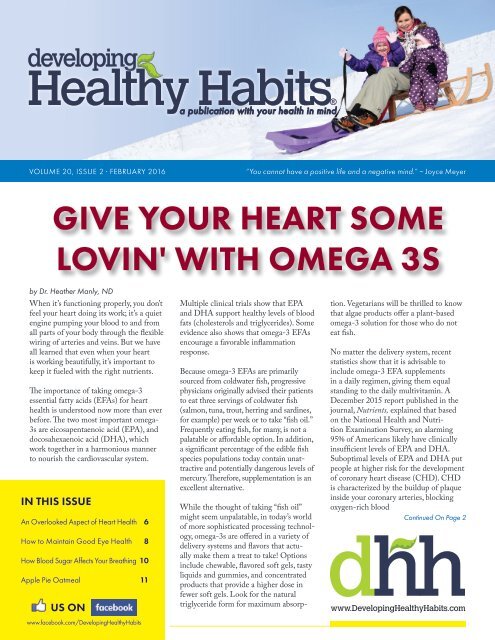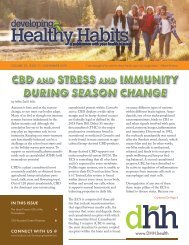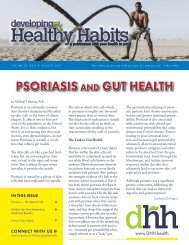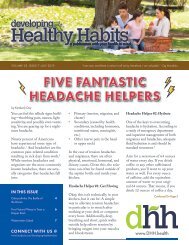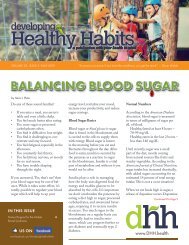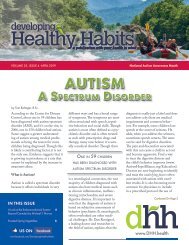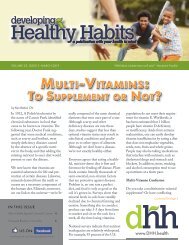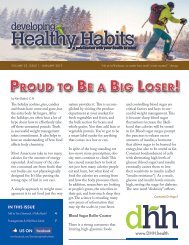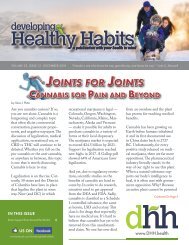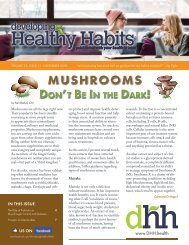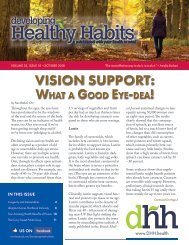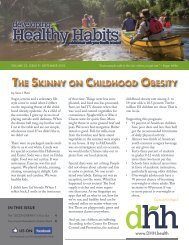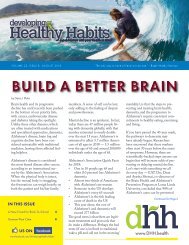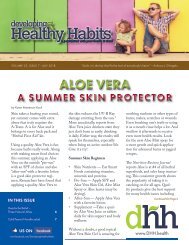February 2016
Create successful ePaper yourself
Turn your PDF publications into a flip-book with our unique Google optimized e-Paper software.
VOLUME 20, ISSUE 2 · FEBRUARY <strong>2016</strong><br />
“You cannot have a positive life and a negative mind.” ~ Joyce Meyer<br />
GIVE YOUR HEART SOME<br />
LOVIN' WITH OMEGA 3S<br />
by Dr. Heather Manly, ND<br />
When it’s functioning properly, you don’t<br />
feel your heart doing its work; it’s a quiet<br />
engine pumping your blood to and from<br />
all parts of your body through the flexible<br />
wiring of arteries and veins. But we have<br />
all learned that even when your heart<br />
is working beautifully, it’s important to<br />
keep it fueled with the right nutrients.<br />
The importance of taking omega-3<br />
essential fatty acids (EFAs) for heart<br />
health is understood now more than ever<br />
before. The two most important omega-<br />
3s are eicosapentaenoic acid (EPA), and<br />
docosahexaenoic acid (DHA), which<br />
work together in a harmonious manner<br />
to nourish the cardiovascular system.<br />
IN THIS ISSUE<br />
An Overlooked Aspect of Heart Health<br />
How to Maintain Good Eye Health<br />
How Blood Sugar Affects Your Breathing 10<br />
Apple Pie Oatmeal<br />
US ON<br />
www.facebook.com/DevelopingHealthyHabits<br />
6<br />
8<br />
11<br />
Multiple clinical trials show that EPA<br />
and DHA support healthy levels of blood<br />
fats (cholesterols and triglycerides). Some<br />
evidence also shows that omega-3 EFAs<br />
encourage a favorable inflammation<br />
response.<br />
Because omega-3 EFAs are primarily<br />
sourced from coldwater fish, progressive<br />
physicians originally advised their patients<br />
to eat three servings of coldwater fish<br />
(salmon, tuna, trout, herring and sardines,<br />
for example) per week or to take “fish oil.”<br />
Frequently eating fish, for many, is not a<br />
palatable or affordable option. In addition,<br />
a significant percentage of the edible fish<br />
species populations today contain unattractive<br />
and potentially dangerous levels of<br />
mercury. Therefore, supplementation is an<br />
excellent alternative.<br />
While the thought of taking “fish oil”<br />
might seem unpalatable, in today’s world<br />
of more sophisticated processing technology,<br />
omega-3s are offered in a variety of<br />
delivery systems and flavors that actually<br />
make them a treat to take! Options<br />
include chewable, flavored soft gels, tasty<br />
liquids and gummies, and concentrated<br />
products that provide a higher dose in<br />
fewer soft gels. Look for the natural<br />
triglyceride form for maximum absorption.<br />
Vegetarians will be thrilled to know<br />
that algae products offer a plant-based<br />
omega-3 solution for those who do not<br />
eat fish.<br />
No matter the delivery system, recent<br />
statistics show that it is advisable to<br />
include omega-3 EFA supplements<br />
in a daily regimen, giving them equal<br />
standing to the daily multivitamin. A<br />
December 2015 report published in the<br />
journal, Nutrients, explained that based<br />
on the National Health and Nutrition<br />
Examination Survey, an alarming<br />
95% of Americans likely have clinically<br />
insufficient levels of EPA and DHA.<br />
Suboptimal levels of EPA and DHA put<br />
people at higher risk for the development<br />
of coronary heart disease (CHD). CHD<br />
is characterized by the buildup of plaque<br />
inside your coronary arteries, blocking<br />
oxygen-rich blood<br />
Continued On Page 2<br />
www.DevelopingHealthyHabits.com
Developing Healthy Habits<br />
Published by:<br />
Developing Healthy Habits, LLC.<br />
3275 S. John Young Parkway, Suite 152<br />
Kissimmee, FL 34746<br />
1-800-713-2802<br />
www.DevelopingHealthyHabits.com<br />
Executive Editor | Mark A. Carroll<br />
Mark@DevelopingHealthyHabits.com<br />
Managing Editor | Sandra Michalski<br />
Marketing/Editor | Nicholas A. Carroll<br />
Design | NXS Designs & JAM Graphics Design<br />
Suzy Cohen, RPh<br />
Mark J. Kaylor<br />
Contributors<br />
Heather Manly, ND<br />
Danielle Myers<br />
To subscribe visit:<br />
www.DevelopingHealthyHabits.com<br />
For content contribution contact:<br />
Sandra@DevelopingHealthyHabits.com<br />
For advertising inquires contact:<br />
Nick@DevelopingHealthyHabits.com<br />
Mission Statement<br />
“Our mission is to continually provide<br />
a well written and clearly presented newsletter<br />
that is devoted to empowering individuals<br />
to make educated decisions relating to their<br />
health and wellness.”<br />
OMEGA 3S — Continued from Page 1<br />
supply to the heart, which is required<br />
for healthy function.<br />
This report adds significant weight to a<br />
2013 Harvard School of Public Health<br />
study showing that adults aged 16<br />
and older that had higher blood levels<br />
of EPA and DHA also had healthier<br />
cardiovascular systems with age. Evidence<br />
is so compelling for the value of<br />
omega-3 EFAs in the human diet that<br />
the esteemed American Heart Association<br />
has officially acknowledged them,<br />
recommending 1000 mg daily.<br />
Blood Fats<br />
Your individual cholesterol levels<br />
(LDL–”bad,” VLDL–very “bad,”<br />
HDL–”good,” and TC–”total”) are a<br />
combination of diet and genetics—what<br />
your liver naturally produces. These<br />
lipoproteins circulate in your blood.<br />
Problems arise when the LDL and<br />
VLDL (meaning low-density and very<br />
low density), which are lethargic in<br />
nature, deposit themselves in your cardiovascular<br />
arteries, causing blockages<br />
as the deposits harden through time.<br />
Your blood fat profile also includes triglycerides<br />
(TG), a basic blood lipid that<br />
ferries adipose fat and glucose produced<br />
in the liver to the rest of the body.<br />
EPA and DHA supplementation helps<br />
to create healthy blood fat profiles.<br />
As one example, a meta-analysis (a<br />
statistics-oriented review of study<br />
results) found that omega-3s can<br />
reduce triglyceride levels in individuals<br />
with higher than normal (undesirable)<br />
TG after only several weeks of daily<br />
consumption. The study points out that<br />
some EPA trials have shown up to 30%<br />
TG reduction, but more commonly,<br />
decreases ranged between 15 and 20%.<br />
Interestingly, both EPA and DHA<br />
have different affinities for blood<br />
fats, which is a key reason why most<br />
omega-3 supplements for cardiovascular<br />
health contain both. The meta-analysis<br />
reviewed studies centering on the<br />
effects on blood fats of supplementing<br />
with EPA only, with DHA only, or<br />
with both EPA and DHA. DHA had<br />
a tendency to raise LDL (bad), yet also<br />
increased HDL (good). EPA reduced<br />
LDL, but had no effect on HDL. 1<br />
A 2015 review of EPA and DHA studies<br />
(culled from two major trials called<br />
MARINE and ANCHOR), seemed<br />
to favor the powers of EPA. Both<br />
showed its ability to lower TG, and<br />
approximately 4 grams per day of EPA<br />
decreased TG and total cholesterol,<br />
yet had no effect on LDL. The study<br />
authors commented that EPA provided<br />
a more favorable blood-fat profile, but<br />
also seemed to impact cardiovascular<br />
inflammation. 2<br />
Inflammation<br />
Overactive (and unhealthy)<br />
inflammation response, notably chronic<br />
inflammation, damages the heart.<br />
Research has shown that the molecular<br />
mechanism underlying chronic<br />
inflammation dramatically contributes<br />
to the growth of artery clogging<br />
plaques. A chief biochemical responsible<br />
for causing chronic inflammation<br />
is C-reactive protein, and one study in<br />
2011 found that participants who took<br />
omega-3 EFAs exhibited reduced levels<br />
of C-reactive protein. 3<br />
A controllable aspect of chronic<br />
inflammation is diet, in collaboration<br />
with omega-3 supplementation. Here’s<br />
why. The typical Western diet is very<br />
high in omega-6 polyunsaturated fatty<br />
acids, at the expense of essential omega-<br />
3s. The healthy balance, say nutritionists,<br />
is 1:1. The typical ratio among<br />
Continued On Page 4<br />
The statements and products in this newsletter<br />
have not been evaluated by the Food and Drug<br />
Administration and are not intended to diagnose,<br />
treat, cure or prevent any disease.<br />
2 <strong>February</strong> <strong>2016</strong> • www.DevelopingHealthyHabits.com
Love<br />
with Essential Omega-3s<br />
Omega-3s for<br />
n Healthy Heart *<br />
n Brain Health *<br />
n Joint Mobility *<br />
Choose Nordic Naturals<br />
The # 1 Omega-3 Fish Oil †<br />
Pure<br />
Effective<br />
Award Winning<br />
Committed to Delivering the World’s<br />
Safest, Most Effective Omega Oils <br />
† Based on SPINS Scan Data<br />
| 800.662.2544 | nordicnaturals.com<br />
* These statements have not been evaluated by the Food and Drug Administration.<br />
This product is not intended to diagnose, treat, cure, or prevent any disease.
OMEGA 3S — Continued from Page 2<br />
American adults is estimated to now be<br />
dramatically in favor of omega-6, at about<br />
15:1. A long-term intake of this skewed<br />
ratio is believed to be a trigger that<br />
produces cardiovascular disease, among<br />
others. One researcher pointed out that in<br />
prevention of cardiovascular disease, even<br />
a ratio of 4:1 was associated with a 70%<br />
decrease in total mortality. 4<br />
It’s simple, really. Omega-6 fatty acids<br />
are pro-inflammatory, so the more you<br />
eat, the more you are at risk for chronic<br />
inflammation that stresses your cardiovascular<br />
system. The worst offenders are<br />
vegetable oils, such as safflower, sunflower,<br />
corn, cottonseed, sesame and soybean.<br />
Omega-6 fatty acids also include arachidonic<br />
acid, found primarily in red meat.<br />
Fish, however, contain only omega-3s and<br />
absolutely no omega-6. Omega-3 EFAs<br />
have been shown to reduce inflammatory<br />
response.<br />
While concentrating on reducing your<br />
omega-6 intake and eating healthier,<br />
nutritious foods is a great start. Omega-3<br />
EFA supplementation is an easy way<br />
to make sure you achieve the omega-3<br />
levels you need to support a healthy heart.<br />
International health experts recommend<br />
that if you simply want to avoid omega-3<br />
deficiency, take 500 mg EPA and DHA<br />
daily. For proactive support, double that<br />
to 1 gram (1000 mg), and for highintensity<br />
support, up it to 2 to 4 grams<br />
of EPA+DHA. If you are just starting to<br />
renovate your diet, the latter is particularly<br />
beneficial to begin immediately<br />
coaxing your omega-6: omega-3 ratio to a<br />
much healthier balance.<br />
Yes, perusing the shelves for the right<br />
omega-3 supplement for you can be a bit<br />
confusing. But there is one way to guarantee<br />
that the product is fresh and free<br />
from contaminants: Ask the manufacturer<br />
for a certificate of analysis for the product<br />
you wish to purchase. This will be your<br />
ticket to understanding the quality of<br />
your selection and the transparency of the<br />
company, and will make your choice so<br />
much easier. And there’s nothing “fishy”<br />
about that!<br />
References:<br />
1<br />
Eslick, GD, et al, Int J Cardiol. 2009 Jul<br />
24;136(1):4-16<br />
2<br />
Singh, S., Am J Ther. 2015 Mar 31.<br />
3<br />
Clin Lipidol 2011. 6(6), 723-9<br />
4<br />
Simopoulos, Biomedicine & Pharmacotherapy.<br />
Vol 56, #8, Oct. 2002, 365-79.<br />
Author’s<br />
Bio:<br />
Dr. Heather Manley, ND, is a naturopathic<br />
physician who lives and practice on the<br />
Big Island of Hawaii. A graduate of the<br />
National College of Naturopathic Medicine<br />
in Portland, Oregon, Dr. Heather focuses on<br />
preventative health care for families. Her goal<br />
is to empower families to be confident and<br />
proactive in their everyday health. A contributing<br />
writer to Dandelion Moms, Organic<br />
Eats magazine, Parents Canada, and KIWI<br />
magazine, Dr. Heather is also the award-winning<br />
author of The Human Body Detectives<br />
book and curriculum series.<br />
®<br />
Suitable for adults and<br />
children age 8 and older<br />
www.natrenhealth.com<br />
Serious Probiotics for those<br />
who take their health seriously<br />
**Natren does not use any ingredients produced by biotechnology<br />
©<strong>2016</strong> by Natren Inc. All rights reserved. The symbol ® denotes a registered trademark of Natren Inc. Made in the USA.<br />
These statements have not been evaluated by the Food and Drug Administration. These products are not intended to diagnose, treat, cure or prevent any disease.<br />
RDHH216<br />
4 <strong>February</strong> <strong>2016</strong> • www.DevelopingHealthyHabits.com
What makes Genacol unique?<br />
Genacol ® is a bioactive collagen hydrolysate complex supported by Genacol’s exclusive<br />
AminoLock ® Sequence Technology that allows specific enhancements to the amino<br />
acids contained in the collagen.<br />
4,4<br />
4,3<br />
4,2<br />
4,1<br />
4<br />
3,9<br />
3,8<br />
3,7<br />
3,6<br />
Two independent clinical studies have confirmed<br />
the benefits of this technology on joint pain when<br />
taking only 1.2 grams of this collagen a day.<br />
The technology reduces the molecular weight<br />
to allow an increase of absorption into the system<br />
as compared to other collagen products.<br />
3,5<br />
Base 6 MONTHS Base 6 MONTHS<br />
GeNacOl ® HYDROlYZeD<br />
OTHeR<br />
cOllaGeN<br />
The study results demonstrated that Genacol<br />
increased the synovial space of joints during the<br />
6 month trial period compared to the placebo patients<br />
that saw a decrease during that same time period.<br />
A principal source of joint pain is caused when<br />
synovial space is diminished which in turn accelerates<br />
deterioration of the cartilage.<br />
pASTure<br />
rAiSed<br />
AminoLock ®<br />
Sequence Technology<br />
Our unique formula includes a complex of several<br />
amino acid sequences using Genacol’s exclusive<br />
Aminolock ® Sequence Technology.<br />
* These statements have not been evaluated by the Food<br />
and Drug Administration. This product is not intended to<br />
diagnose, treat, cure, or prevent any disease.<br />
TO FIND OUT MORE,<br />
ask FOR YOUR free booklet!<br />
“ What science tells us about our joints”<br />
1 888 514-3622<br />
www.genacol.com<br />
www.DevelopingHealthyHabits.com • January <strong>2016</strong> 5
y Mark J Kaylor<br />
An Overlooked Aspect of<br />
HEART HEALTH<br />
Every 20 seconds someone in the US has<br />
a heart attack, while every 34 seconds<br />
someone dies of heart disease. With<br />
these kinds of statistics, you’d think we'd<br />
be doing everything we can to prevent<br />
cardiovascular disease. But are we?<br />
There’s more to heart health than most<br />
folks think. Typically, when one hears<br />
about blood sugar and insulin, most of us<br />
immediately think of diabetes. Did you<br />
know though, that blood sugar and insulin<br />
imbalances are actually at the “heart”<br />
of many cardiovascular concerns?<br />
The primary issue here is a process that<br />
involves our cells becoming less and less<br />
sensitive to insulin, thereby raising blood<br />
sugar levels and causing the pancreas<br />
to continually produce more and more<br />
insulin. This then becomes a pernicious<br />
cycle, as the cells react negatively to the<br />
excessive insulin production that then<br />
leads to even more insulin resistance.<br />
Insulin resistance is a risk factor for high<br />
triglycerides, obesity, coronary artery<br />
disease, atherosclerosis, dyslipidemia,<br />
hypertension, homocysteine and clotting<br />
issues.<br />
The Good News<br />
The good news is that there is much<br />
we can do to prevent insulin resistance<br />
as well as improve our insulin sensitivity.<br />
There is a specific extraction of the<br />
Maitake mushroom called SX-fraction<br />
that, in multiple lab and clinical studies,<br />
demonstrated the ability to effectively<br />
lower both blood sugar and insulin levels.<br />
Evidence of its ability to improve insulin<br />
sensitivity and support heart health is<br />
found in its research confirmed ability to<br />
lower blood pressure, LDL cholesterol,<br />
HbA1c and triglycerides.<br />
With research coming out almost daily<br />
emphasizing the importance of maintaining<br />
healthy blood sugar and insulin<br />
levels, as well as a number of other health<br />
concerns, it may behoove us to be more<br />
attentive to these important measures of<br />
our health.<br />
Author’s<br />
Bio:<br />
Mark J. Kaylor has been<br />
exploring holistic health<br />
and healing for close to<br />
four decades. He is the<br />
founder and director of the not-for-profit<br />
Radiant Health Project. Mark welcomes your<br />
comments and questions and can be contacted<br />
at his website:<br />
www.RadiantHealthProject.com<br />
or on facebook at<br />
www.facebook.com/RadiantHealthProject.<br />
6 <strong>February</strong> <strong>2016</strong> • www.DevelopingHealthyHabits.com
www.DevelopingHealthyHabits.com • January <strong>2016</strong> 13
Seeing the Whole Picture:<br />
How to Maintain Good Eye Health<br />
by Danielle Myers<br />
The age-old expression, “the eyes are<br />
the windows to the soul,” could have<br />
more meaning than we realize. Our<br />
eyes tell us a lot about our bodies<br />
and our health. Taking care of these<br />
organs not only helps prevent disease,<br />
but can improve our overall health.<br />
According to the Centers for Disease<br />
Control and Prevention (CDC), more<br />
than 3.3 million Americans aged<br />
40 years and older are either legally<br />
blind or have low vision. The leading<br />
causes of blindness and low vision<br />
in the United States are primarily<br />
age-related eye diseases such as macular<br />
degeneration, cataract, diabetic<br />
retinopathy and glaucoma.<br />
According to Bausch & Lomb,<br />
80 percent of visual impairment is<br />
preventative. Maintaining good eye<br />
health and protecting our vision can<br />
be accomplished in many ways every<br />
day. Two important contributing factors<br />
to consider are lifestyle and diet.<br />
Lifestyle Habits for Healthy Eyes<br />
Having healthy eyes means more than<br />
just having good vision. Our everyday<br />
lifestyle can have a major effect on the<br />
long-term condition of our eyes. Take<br />
a step back and consider five tips to<br />
promote eye health, according to the<br />
National Eye Institute (NEI):<br />
1. Eat Healthy — Eating a healthy<br />
diet that is rich in nutrients can<br />
promote eye health benefits.<br />
People who are overweight are at<br />
risk of developing diabetes and<br />
other systemic conditions that<br />
can lead to vision loss.<br />
2. Quit Smoking — Smoking can<br />
cause an increased risk of agerelated<br />
macular degeneration,<br />
cataract and optic nerve damage,<br />
all of which can lead to blindness.<br />
3. Wear Protective Eyewear<br />
— Whether its sunglasses,<br />
eyeglasses, or safety glasses —<br />
protect your eyes! You can never<br />
be too careful when working<br />
around objects that could cause<br />
damage to your eyes. One in<br />
particular is the sun. Sunglasses<br />
should block 99% to 100% of<br />
both UVA and UVB rays.<br />
4. Rest Your Eyes — Looking at a<br />
computer monitor for hours can<br />
strain your eyes. According to<br />
Mark Rosenfield, PhD, professor<br />
of clinical education at the State<br />
University of New York College<br />
of Optometry, the average person<br />
blinks up to two-thirds less often<br />
per minute while looking at a<br />
screen. Try the 20-20-20 rule:<br />
every 20 minutes, look 20 feet<br />
away for 20 seconds. This can<br />
help reduce eyestrain.<br />
5. Visit Your Eye Doctor Regularly —<br />
Many common eye diseases such<br />
as glaucoma, diabetic eye disease<br />
and age-related macular degeneration<br />
often have no warning<br />
signs. A dilated eye exam is the<br />
only way to detect these diseases<br />
in their early stages. Many eye<br />
diseases and conditions are hereditary,<br />
so talk to family members<br />
about eye health history.<br />
Eat Right for Good Sight<br />
Proper nutrition is paramount for<br />
maintaining and preserving healthy<br />
eyes. Foods rich in anti-oxidants<br />
and essential omega-3 fatty acids are<br />
important to the health of the macula,<br />
the part of the eye responsible for<br />
central vision. Diets high in fat can<br />
actually cause deposits that constrict<br />
blood flow in the arteries. So which<br />
foods are actually good for the eyes?<br />
For many, the first food that comes to<br />
mind is carrots. These orange veggies<br />
are full of beta-carotene, which helps<br />
the retina and other parts of the eye<br />
function. While beta-carotene has an<br />
importance place in eye health diet,<br />
there are a few other foods rich in<br />
vitamins and minerals that are essential<br />
for healthy eyes, according to the<br />
American Optometric Association<br />
(AOA):<br />
Green, Leafy Vegetables<br />
Why: Anti-oxidants<br />
Dark, leafy greens – such as kale,<br />
spinach, and collards – are packed<br />
Continued On Page 9<br />
8 <strong>February</strong> <strong>2016</strong> • www.DevelopingHealthyHabits.com
GOOD EYE HEALTH — Continued from Page 8<br />
with lutein and zeaxanthin, which are<br />
anti-oxidants that lower the risk of<br />
developing macular degeneration and<br />
cataracts. Lutein and zeaxanthin may<br />
also act like natural sunglasses, helping<br />
to form macular pigment that<br />
filters out some of the sun’s damaging<br />
rays.<br />
Fatty Fish<br />
Why: Omega-3 fatty acids<br />
Fish such as tuna, salmon, mackerel,<br />
anchovies and trout are rich in<br />
docosahexaenoic acid (DHA), a fatty<br />
acid found in the nerve cells in the<br />
retina. These nutrients help protect<br />
against macular degeneration and dry<br />
eye syndrome, and decrease the risk<br />
of eye pressure and glaucoma.<br />
Citrus and berries<br />
Why: Vitamin C<br />
These fruits contain Vitamin C<br />
which helps the body form and<br />
maintain connective tissue, including<br />
collagen found around the cornea<br />
of the eye. Vitamin C can also help<br />
reduce the risk of developing macular<br />
degeneration and cataracts.<br />
Eggs<br />
Why: Zinc and Anti-oxidants<br />
Egg yolks contain zinc, as well as<br />
other anti-oxidants which play an<br />
important role in bringing vitamin A<br />
from the liver to the retina, in order<br />
to produce melanin, a protective pigment<br />
in the eye. Zinc can also help<br />
reduce risk of macular degeneration.<br />
Nuts<br />
Vitamin E<br />
Many nuts, particularly almonds, are<br />
filled with Vitamin E which can help<br />
protect membranes of cells throughout<br />
the body, and can slow the progression<br />
of macular degeneration.<br />
SEE Your Doctor<br />
A recent survey conducted by Bausch<br />
& Lomb found that 70 percent of<br />
people would rather lose a limb or<br />
give up 10 years of their life than<br />
lose their eyesight. However, only 21<br />
percent of those surveyed had regular<br />
eye exams in the past five years. A<br />
regular eye exam is the best way to<br />
protect your eyesight. The National<br />
Institutes of Health (NIH) recommend<br />
a complete eye exam every five<br />
to 10 years for adults between the<br />
ages of 20 and 39, every two to four<br />
years for adults between the ages of<br />
40 to 50, every one to three years<br />
for adults between the ages of 55 to<br />
64, and every one to two years for<br />
adults ages 65 and older. Since many<br />
eye problems do not have physical<br />
symptoms until they become more<br />
advanced, it is vital that a regular eye<br />
exam is scheduled.<br />
The Big Picture<br />
Living in a digital world, our eyes<br />
look from screen to screen throughout<br />
the day. Taking preventative<br />
measures and providing proper care<br />
for these precious organs can help<br />
to prevent disease and improve our<br />
overall health. So, step back and take<br />
a look at the big picture by maintaining<br />
good eye health!<br />
Author’s<br />
Bio:<br />
Danielle Myers is a freelance<br />
writer and public relations professional<br />
from the Philadelphia area.<br />
As an avid traveler and foodie, she<br />
enjoys writing articles for health,<br />
travel, and food publications.<br />
• Leading the way with<br />
natural healing<br />
• Non-gmo verification<br />
Thin After 40<br />
Supports weight control<br />
with a metabolic<br />
enhancing blend of<br />
26 whole herbs.<br />
Fat & Sugar Detox<br />
Supports metabolism of<br />
fats and sugars with the<br />
detoxifying blend of<br />
29 whole herbs.<br />
Cellulite Tone<br />
Supports the body with<br />
a natural blend of<br />
17 toning whole herbs.<br />
Tummy Control<br />
Supports weight<br />
control and relieves<br />
stress with a blend of<br />
35 whole herbs.<br />
800-736-6015<br />
HealthyHealing.com<br />
AloeDigestiveAd2.375x4.625_Aloe SkinGel Ad 3.8x5 1<br />
Healthy in <strong>2016</strong>?<br />
Herbal Aloe<br />
Detox Team<br />
Detox Plus Juice<br />
Fiber Mate Tablets<br />
• Tastes Good & Works Fast<br />
• Best on the market for<br />
Body Wellness<br />
• Kids 4+, Adults, Athletes<br />
plus Gluten Free!<br />
Satisfaction Guaranteed! • Since 1991<br />
1-800-414-ALOE • www.aloelife.com<br />
www.DevelopingHealthyHabits.com • <strong>February</strong> <strong>2016</strong> 9
How Blood Sugar<br />
Affects Your Breathing<br />
by Suzy Cohen, RPh<br />
When you think of diabetes, either type<br />
1 or 2, the possibility of complications<br />
affecting your eyes, heart and kidney<br />
come to mind. But you never really think<br />
of your lungs having problems as a result<br />
of blood sugar abnormalities. That’s<br />
unfortunately a little-known fact.<br />
Diabetes (diagnosed or not) spawns a ton<br />
of oxidative stress throughout your body.<br />
Lung tissue gets affected by poor blood<br />
sugar dysregulation and all the free radicals<br />
killing the innocent cells just trying<br />
to ‘breathe,’ if you know what I mean.<br />
Lung tissue has an extensive network of<br />
blood vessels, especially the tiniest ones<br />
called capillaries. Capillaries allow blood<br />
cells carrying oxygen to march through<br />
their vessel walls, but slowly, one cell at<br />
a time, kind of like soldiers marching<br />
one by one behind each other. Capillaries<br />
are the most fragile because they<br />
are so thin. Your lungs are also made up<br />
of large amounts of connective tissue.<br />
Capillaries get destroyed when excessive<br />
glucose molecules attach to them and<br />
cause stiffening, so then they can’t bend<br />
anymore due to the formation of AGE<br />
or “Advanced Glycation End” products.<br />
A lot of inflammatory cytokines form<br />
too. It’s the same case in your eyes, heart,<br />
kidneys and nerves. That’s why diabetic<br />
complications occur.<br />
This leads to swelling and scar tissue,<br />
which builds up in the air-pockets and<br />
airways of your lung tissue. The capillary<br />
tissues fill up with inflammatory cells<br />
and fibrin. This process depletes your<br />
anti-oxidants, like glutathione and SOD.<br />
More problems if you have a SNP that<br />
slows production of either of those! It<br />
gets harder to breathe, you’re tired, and<br />
you develop shortness of breath with little<br />
or no exertion. Forget about exercising<br />
now. To boot, your new sedentary state<br />
causes weight gain and that taxes your<br />
heart, increasing cardiovascular complications<br />
from diabetes. It can apparently be<br />
addressed, if only partially.<br />
In a July 2015 study, researchers tested<br />
the lung health of type 2 diabetic rodents<br />
demonstrating that if they gave the critters<br />
some chromium, zinc and leucine,<br />
their lung health improved, like, a lot!<br />
They tried the nutrients separately and<br />
in combination. In all scenarios, the<br />
anti-oxidant status improved and lung<br />
inflammation reduced. In some cases it<br />
diminished entirely. Chromium, zinc and<br />
leucine didn’t just reduce blood sugar;<br />
they also protected those fragile capillaries<br />
and connective tissue from the<br />
cytokine storm, while improving antioxidant<br />
status. In other words, nutrients<br />
that reduce complications of diabetes are<br />
as important as those that reduce blood<br />
sugar.<br />
In November 2015, new research focused<br />
on type 1 diabetes and mineral status.<br />
Scientists measured blood levels of<br />
chromium, zinc and magnesium and<br />
they were reduced in all participants. In<br />
fact, the most poorly controlled diabetics<br />
seemed to have the worst deficiencies.<br />
The research confirms that chromium,<br />
zinc and magnesium may be useful for<br />
people seeking to reduce complications.<br />
So many of you are focused on the blood<br />
sugar number, and you only judge your<br />
success by the numbers shown on the<br />
glucose machine. But I’m warning you<br />
that it’s more important to focus on capillaries,<br />
connective tissue and inflammation<br />
chemicals. We know certain herbs and<br />
minerals support healthy nerves, capillaries,<br />
eyes, kidneys and airways. This<br />
reduces complications. If you’re taking a<br />
supplement but not seeing the numbers<br />
go down, it may still be working. You’d<br />
never even realize it if you’re just evaluating<br />
your progress with a blood glucose<br />
machine.<br />
Author's Bio:<br />
Suzy Cohen, RPh<br />
has been a licensed<br />
pharmacist for 22<br />
years and is a functional<br />
medicine<br />
practitioner. Dubbed<br />
as ‘America’s most<br />
trusted pharmacist,’ she devotes most<br />
of her time to teaching others about the<br />
benefits of natural vitamins, herbs and<br />
minerals. In addition to writing her own<br />
syndicated health column, “Dear Pharmacist,”<br />
which has appeared in the South<br />
Florida Sun-Sentinel for 13 years, Suzy<br />
is the author of three best-selling books<br />
on natural health: The 24-Hour Pharmacist<br />
(Collins 2007), Diabetes Without<br />
Drugs (Rodale 2010) and her newest<br />
release, Drug Muggers (Rodale 2011)<br />
which teaches consumers about how<br />
their medications may be slowly stealing<br />
the life out of them, and how restoring<br />
vitamins and minerals can prevent side<br />
effects and restore vibrant health. Suzy<br />
has appeared on The Dr. OZ Show, The<br />
Doctors, The View, The 700 Club and Good<br />
Morning America Health. You can ask<br />
your own health question or read archived<br />
articles at www.SuzyCohen.com<br />
10 <strong>February</strong> <strong>2016</strong> • www.DevelopingHealthyHabits.com
⅓ cup regular oats<br />
1 tbsp chia seeds<br />
1 tsp ground cinnamon<br />
¼ tsp ground ginger + pinch salt<br />
1¼ cup almond milk<br />
RECIPE<br />
OF THE MONTH<br />
APPLE PIE OATMEAL<br />
Prep Time: 10 Minutes — Cook Time: 15 Minutes — Serves 1<br />
INGREDIENTS:<br />
1 Granny Smith apple,<br />
peeled and cut into 1 inch pieces<br />
1½ tablespoon pure maple syrup + more<br />
for drizzling<br />
1/2 cup unsweetened applesauce<br />
DIRECTIONS:<br />
1. In a medium sized pot over medium heat, whisk together the ⅓ cup oats, peeled and chopped apple,<br />
1 tbsp chia seeds, ½ cup unsweetened applesauce, 1¼ cups almond milk, 1 tbsp pure maple syrup,<br />
1 tsp cinnamon, ¼ tsp ginger, pinch of kosher salt. Whisk well.<br />
2. Heat over medium heat for about eight minutes, stirring often.<br />
When the mixture thickens and the liquid is absorbed, it is ready. Stir in the pure vanilla extract.<br />
3. Pour into a dish and sprinkle with chopped walnuts, a pinch of cinnamon,<br />
and a drizzle of pure maple syrup. Add a tiny bit of almond milk on top.<br />
“Like” us at www.facebook.com/DevelopingHealthyHabits<br />
Also, check us out at www.DevelopingHealthyHabits.com<br />
1/2 tsp pure vanilla extract<br />
1 tsp fresh lemon juice<br />
2 tbsp chopped walnuts, for sprinkling<br />
on top<br />
www.DevelopingHealthyHabits.com • <strong>February</strong> <strong>2016</strong> 11
Increase energy*<br />
Promote regularity*<br />
Soothe digestive*<br />
www.enzymedica.com<br />
AS SEEN IN<br />
January 11, <strong>2016</strong><br />
“Fortunately there’s an easy way to banish bloat<br />
and prime the body for slimming in the new year:<br />
Take an enzyme supplement like Enzymedica Digest.”


